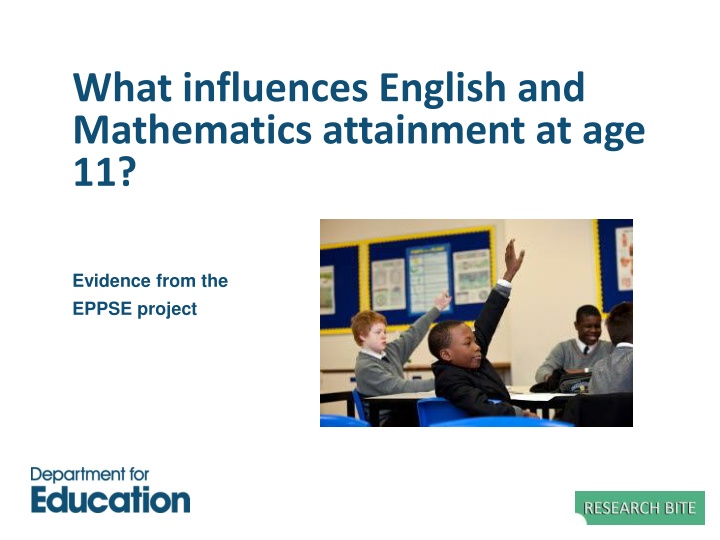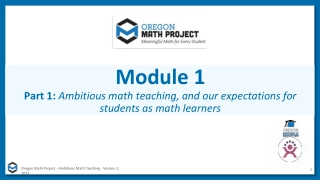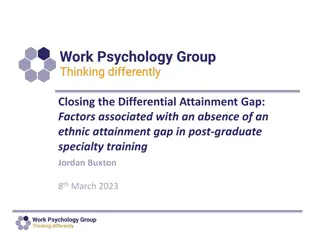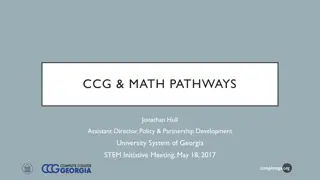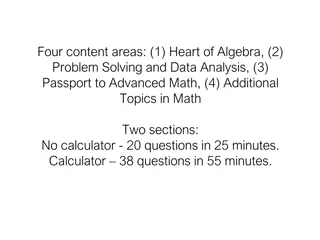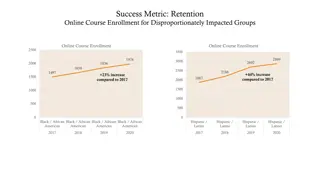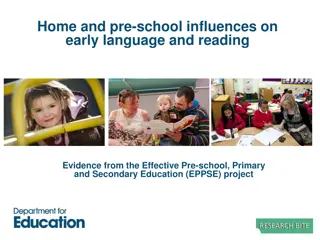Influences on English and Math Attainment at Age 11: Insights from EPPSE Project
Evidenced from the EPPSE project, various factors influence English and Mathematics attainment at age 11. Child and family characteristics play a significant role, with girls performing better in English and boys in Mathematics. Children from families with higher-educated mothers tend to excel. Learning at home, especially in a conducive environment, is crucial for children's academic success, particularly in English. Additionally, a positive pre-school experience significantly impacts children's attainment levels, emphasizing the importance of quality pre-school education.
Download Presentation

Please find below an Image/Link to download the presentation.
The content on the website is provided AS IS for your information and personal use only. It may not be sold, licensed, or shared on other websites without obtaining consent from the author.If you encounter any issues during the download, it is possible that the publisher has removed the file from their server.
You are allowed to download the files provided on this website for personal or commercial use, subject to the condition that they are used lawfully. All files are the property of their respective owners.
The content on the website is provided AS IS for your information and personal use only. It may not be sold, licensed, or shared on other websites without obtaining consent from the author.
E N D
Presentation Transcript
What influences English and Mathematics attainment at age 11? Evidence from the EPPSE project
What is EPPSE? EPPSE is the Effective Pre-School, Primary and Secondary Education Project. It is a longitudinal study that has followed 2,500 children from the age of 3 through pre-school, primary and secondary school. It examines how pre- school, primary school and home background relate to children s achievements and behaviour. EPPSE children were in primary schools from 1999-2007 (from age 3+ to age 11). The children were regularly assessed on their development from the age of 3. There have been interviews with staff in pre-school and school, and assessments of the quality of pre-school and school environments.
There are five key influences on child development at age 11 Child characteristics e.g. gender or birth weight. Family characteristics, e.g. parents education, home language. Child Factors Family Factors Learning opportunities in the home. Mathematics and English attainment at KS2 Learning at home Pre- School Pre-school attendance and experience. Primary School Primary school experience.
Childrens characteristics and their family background predict their outcomes At age 11 girls did significantly better than boys in English, but boys did somewhat better in mathematics. Children with very low birth weight or early health problems did less well in English and mathematics than other children. Mother s education (especially a degree) had a strong positive effect on outcomes in English and mathematics, more so than family income or social class.
What children learn at home is crucial A good environment for learning at home (in the early years), compared to a poor one, had a similar positive effect for children as having a mother with a degree. Learning at home was particularly important for English. Parents who provided a good environment for learning at home taught their children specific skills e.g. letter-sound relationships and improved language and vocabulary. It included activities such as being read to; painting and drawing; going to the library; playing with letters/numbers and learning activities with songs, poems and nursery rhymes. Parents tended to treat girls and boys differently. Overall girls had a better home learning environment.
Good pre-school experience makes a difference to children s attainment Good pre-school/nursery provided an initial boost to pre-reading and early number skills and also helped children progress when at primary school (possibly through developing children s motivation and capacity to learn); pre-schools that helped children to understand early number concepts led to better outcomes in mathematics at 11. Quality is important going to any pre-school had benefits for children when they started primary school, however, only higher quality pre-schools still had an impact on children s attainment at age 11; higher quality pre-schools benefitted all children in primary school and gave a greater boost to development for the most disadvantaged.
Effective primary schools help to counter disadvantaged backgrounds Primary schools varied in the progress pupils made from KS1-KS2 EPPSE pupils made better progress in English and mathematics in more academically effective1 primary schools;. children from highly disadvantaged backgrounds benefited most from attending an academically effective primary school more so than their more advantaged peers. The influence of primary school was more important for attainment and progress in mathematics than in English. Good pre-school experiences offered some protection against poor educational experiences later. Attending a high quality pre-school offered some protection for children who went on to attend less academically effective primary school. 1 - A school s academic effectiveness was measured through analysis of KS1 and 2 results for all schools in England taking account of background characteristics. See related EPPSE Research Bite Effective Teaching Methods in 82 Primary Schools which examines the impact of teaching quality on pupils achievement and the teaching behaviours which have an impact on pupil outcomes.
English the key factors influencing pupils attainment Child, family, and home background are more important in predicting differences in overall pupil s attainment in English than in mathematics Influences on KS2 English 0.8 0.7 Effect Size 0.6 0.5 Pre-school has a significant influence. 0.4 0.3 0.2 The effectiveness of the primary schools a child attends is also important. Pupils who have a combination of good quality pre- school and then attend a more effective primary school have better outcomes. 0.1 0 Gender Birth weight Family income Early home learning Fathers education Pre-school quality Mothers education Home learning during Primary Early developmental problems Primary school effectiveness Family socio-economic status Effect size is a statistical concept that shows the strength of the relationship between an outcome such as National Assessment scores and another variable such as Mothers qualifications, while controlling for other factors. An effect size of 0.1 is relatively weak, one of 0.35 moderately strong, one of 0.7 strong.
Mathematics the key factors influencing pupils attainment Mothers education was still important but other home and family characteristics less so. Influences on KS2 Mathematics 0.8 0.7 0.6 The quality of the pre- school and the effectiveness of the primary school a child attends are also both important for attainment in mathematics. They have stronger effects than either gender or family socio-economic status. Effect size 0.5 0.4 0.3 0.2 0.1 0 Gender Birth weight Family income Early home learning Pre-school variation Fathers education Mothers education Primary School variation Home learning during Primary Family socio-econonic status Early developmental problems Effect size is a statistical concept that shows the strength of the relationship between an outcome such as National Assessment scores and another variable such as Mothers qualifications, while controlling for other factors. An effect size of 0.1 is relatively weak, one of 0.35 moderately strong, one of 0.7 strong.
How can you use the evidence in this study? How do you support the learning of children who don t receive much support for learning at home ? How could you influence the experiences of children before they come to primary school? Can you work with your local pre schools that feed your primary (either based at school or elsewhere)? How can you encourage more involvement of parents in children s learning? In the early years, and throughout primary school?
Authors and Further Reading Principal Investigators for the EPPSE project are: Kathy Sylva (Oxford), Edward Melhuish (Birkbeck), Pam Sammons (Oxford), Iram Siraj-Blatchford & Brenda Taggart (IoE). This Research Bite draws on the EPPSE report: Influences on Children s Attainment and Progress in Key Stage 2: Cognitive Outcomes in Year 6 A short summary (Research Brief) which covers both cognitive and social/behavioural outcomes can be downloaded from the Department for Education website: http://www.education.gov.uk/publications/eOrderingDownload/DCSF-RB048-049.pdf The full report is also available: https://www.education.gov.uk/publications/RSG/publicationDetail/Page1/DCSF-RR048
Further Information EPPSE Website: http://eppe.ioe.ac.uk Or contact Brenda Taggart Principal Investigator and Research Co-ordinator 00 44 (0) 207 612 6219 b.taggart@ioe.ac.uk
